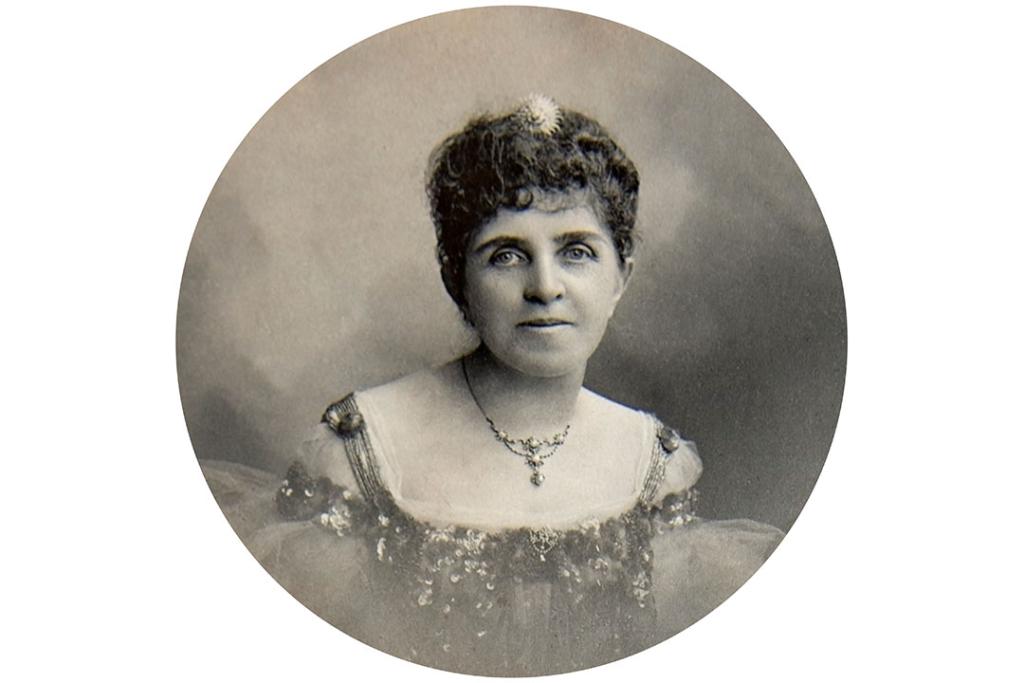Who was Lady Lever?
Plenty is known about Lord Leverhulme, the entrepreneur and founder of Port Sunlight village. However his wife, whom the Lady Lever Art Gallery is named after, is more of an enigma. Her biographer Gavin Hunter introduces us to the woman behind the iconic building.

She came from a humble background
Lady Lever was born Elizabeth Ellen Hulme, the daughter of Crompton Hulme, a master draper who lived with his family over the shop at 2 Deansgate in Bolton. Elizabeth was born there on 4 December 1850. Their shop and home occupied the far end of the four storey building seen on the right of this picture. When it was demolished in the early 1900s to make way for the present building, it is said that the oak fittings from the shop were used to build the organ casing in St George’s Church in Thornton Hough.

The Old Market Place, Deansgate, Bolton, 1836 engraved by Watkins after a picture by J Harwood, courtesy of ancestry.com
She met her future husband when they were children
In early 1860 Mr and Mrs Hulme, ten-year-old Elizabeth and her five-year-old brother John moved round the corner from the draper’s shop in Deansgate to 15 Wood Street. Immediately opposite, on the other side of this narrow cobbled street, was the home of the Lever family where her future husband William lived. Elizabeth probably first met William through his sister, with whom she played rounders in the street.
Next door to the Hulme’s terraced house was the ‘Misses Aspinwall’s School’ where Elizabeth and William both went to school as children.

The former Crompton home and Miss Aspinwall’s School in Wood Street, Bolton and a modern view of the street. Courtesy of Gavin Hunter
On 15 April 1874 Elizabeth, aged 23, married William Hesketh Lever, aged 22, at St George’s Road Congregational Church, Little Bolton. Their first married home was an end-terrace house in Park Street in Bolton. During her lifetime Elizabeth lived in fourteen different homes: eight in Bolton, one in Southport, one in Wigan, two in London, and two on Wirral.
Elizabeth gave birth to seven babies, of which sadly only one survived, William Hulme Lever who later became the second Viscount Leverhulme. The earlier children, all but one unnamed, were buried in the family grave at Stand Chapel. The last two were buried in a grave in Heaton Cemetery near their home in Bolton.
She was honoured by the Royal Geographic Society
Elizabeth was extremely well travelled. She visited Europe, America, Africa and Australia, sailed across the Atlantic fourteen times and round the world twice, in opposite directions. This was before transatlantic flights so all her foreign trips were made by sea and in quite difficult conditions.
Two years after she became Lady Lever, in 1913 Elizabeth was one of the first women to be elected as a Fellow of the Royal Geographical Society in recognition of the extensive world travel that she undertook with her husband. Sadly, she was only able to enjoy this honour for three months before she passed away.

Elizabeth, on one of her many voyages, with her son William Hulme and his governess, Clara Green, who later became Elizabeth's companion. Courtesy of the Leverhulme Family Archive
There were no cruise ships at the time. Vessels didn’t have stabilisers, so passages were often rough. There was no air-conditioning and temperatures could vary from bitterly cold in the southern oceans to searing heat in the heart of Africa.
One of Elizabeth’s longest trips was to Africa in 1912 where she made her final excursion, a 1,400 mile journey up the Congo river with William in the paddle steamer the SS Lusanga. It was during this trip that Elizabeth was given two monkeys, one of which eventually came to live in the fernery at Thornton Manor.
She led an active public life

Elizabeth, wearing one of her characteristic large hats, with some guests in the garden at Thornton Manor. Courtesy of the Leverhulme Family Archive
After Elizabeth and William came to live on Wirral she laid a lot of foundation stones, planted several trees, and ceremonially opened a whole variety of buildings. She was presented with many silver trowels and golden keys at these events.

This key was presented to Elizabeth when she opened the Blackburn Road Sunday School, in Bolton on 19 February 1902. Courtesy of Gavin Hunter
She was a Hulme, then a Lever, but never a Leverhulme
When Elizabeth passed away on 24 July 1913 her husband was a Baronet, Sir William Hesketh Lever. So she was Lady Lever, never Leverhulme.
In 1917 when William was raised to the peerage he created the name Leverhulme in her honour by combining her maiden name Hulme with his name Lever, so he became Baron Leverhulme of Bolton-le-Moors, and in 1922 Viscount Leverhulme of the Western Isles.
He named the gallery ‘Lady Lever Art Gallery’ to commemorate her memory.

© Pete Carr
The art gallery is not the only memorial to her
The fountain in front of the gallery was unveiled in 1950 to commemorate the centenary of Elizabeth's birth.
There are also three memorial windows dedicated to Lady Lever’s memory: one in Christ Church in Port Sunlight, one in St George’s Church in Thornton Hough, and one in St George’s Road Congregational Church in Bolton where she and William were married.

Lady Lever memorial window in St George’s Church in Thornton Hough. Courtesy of Gavin Hunter
Lead image of Lady Lever courtesy of the Leverhulme Family Archive
